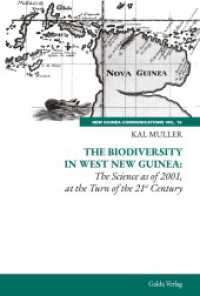Full Description
Universities are grappling with the issue of broadening the knowledgebases of their students to achieve excellence in education through the development and enhancement of intellectual power and capacities, preparing students to shoulder their civil and ethical responsibilities through a sense of personal growth and self-direction that can have real impact. Yet the demand for high impact practices in education is in a constant state of flux due to the ever-evolving reality of today's interconnected world. How can universities develop realistic opportunities through high impact learning and what can be the expected outcome of such learning?
Collating various case studies, policies and other empirical research, High Impact Practices in Higher Education: International Perspectives examines effective high impact learning practices and demonstrates approaches that promote learning communities and common intellectual experiences. Contributors consider theoretical frameworks as well as applied models in terms of benefits gained and challenges encountered for the sake of educators, faculty members and students.
With relevance for every area and discipline within higher education, High Impact Practices in Higher Education: International Perspectives facilitates the advice and support a university may need in its journey towards becoming a progressive, high impact institution.
Contents
PART I: CREATING GLOBAL CITIZENS
Introduction to High Impact Practices in Higher Education: International Perspectives; Enakshi Sengupta
Chapter 1. Virtual reality and virtual exchange, connecting UK and Lebanese students to investigate public health issues in Syrian refugee camps; Henry Dawson, Nael Alami, Keith Bowen, and Diana Maddah
Chapter 2. A high impact program design framework to support future focused curriculum design; Holly Russell, Rachel Fitzgerald, Deanna Meth, and Henk Huijser
Chapter 3. High Impact Practices in the Civil Engineering Major at the United States Air Force Academy; Joel A. Sloan, Melissa S. Beauregard, and M. Mark Russell
Chapter 4. The Significance of Information Literacy and Transparency in Academic Class Discussions; Krisztina Domjan
Chapter 5. Combining High Impact Education Practices and Active Learning Pedagogy to Address Visual Plagiarism in Applied Arts Higher Education; Lisa Winstanley
Chapter 6. The coevolution of knowledge, knowledge management and social competence in Higher Education; Normada Bheekharry
PART II: TOWARDS A HOLISTIC CURRICULUM
Chapter 7. Why science qualifications should be a pre-requisite for a psychology degree programmes - A case study analysis from a UK university; Caroline Hands and Maria Limniou
Chapter 8. Inclusive and flexible curriculum design framework in work-based learning: providing high-impact Transnational Education opportunities in Sub-Saharan Africa; Christopher J. M. Smith, Constantinos Choromides, Victoria Boyd, Linda Proudfoot, Marty Wright, and Fiona Stewart-Knight
Chapter 9. An Analysis of First-Year College English Composition Course Syllabi Using Civic Learning/Community Engagement as Learning Tools; Dean Albert Ramser
Chapter 10. High-impact practices in graduate education: Examples from a program evaluation curriculum; John M. LaVelle, Trupti Sarode, and Satlaj Dighe
Chapter 11. Internationalization strategies in higher education in Mexico: Practices and experiences at Universidad de Monterrey Business School; Karla Maria Nava-Aguirre








